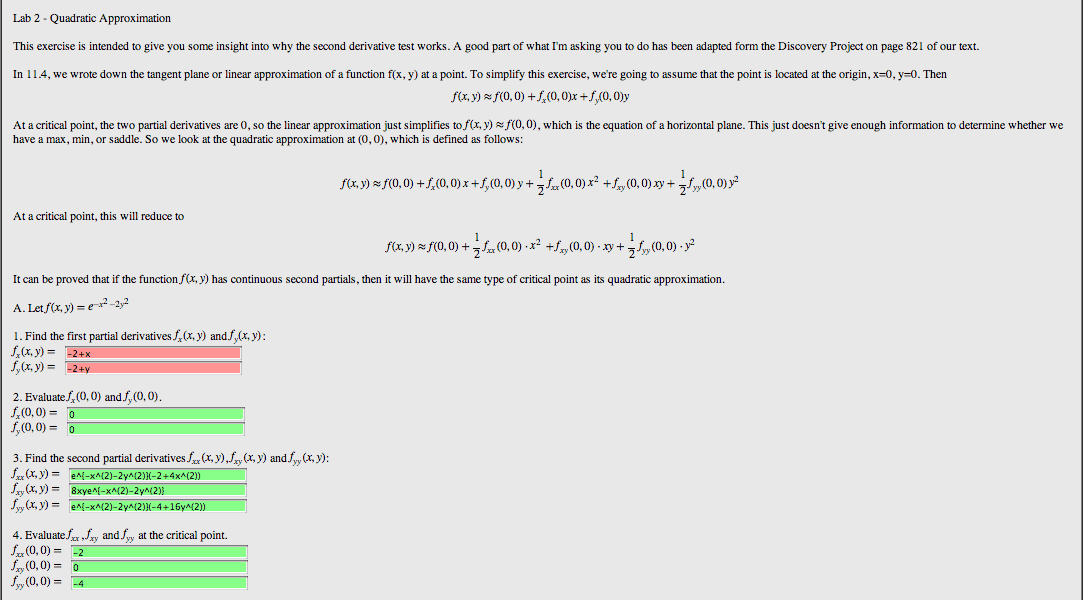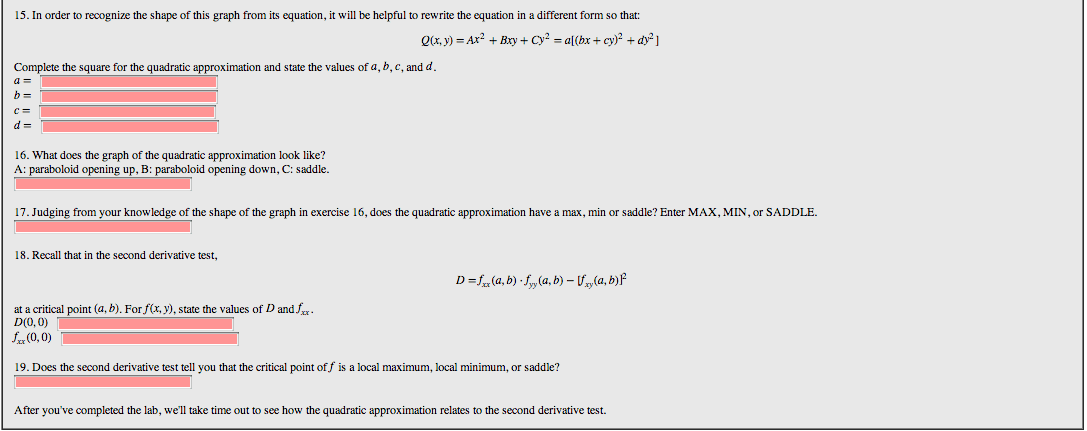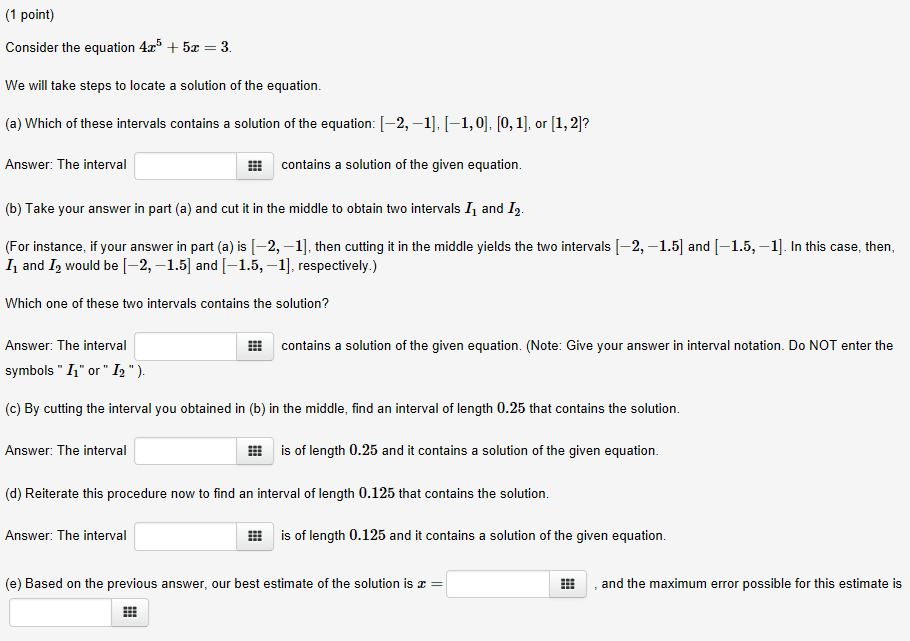PLEASE ANSWER ALL 12 QUESTIONS
In this assignment we are going to look a little closer at the derivative and use it in to find the simple vertex in the quadratic case and then for business type problems[Chapter 19]. Then our last step will be a short view and practice of the anti-derivative (AKA integral)[chapter 29]. Note: you do not need the textbook but it is helpful in reviewing the topics beyond the discussion below. There are also numerous helpful web sites which is also acceptable.
First, we will review the concept of the vertex and then see how a derivative will help us locate the vertex. Consider the equation: y = x2 â 6x + 5. The graph of this equation would look like a smile. It would be decreasing until it got to a specific point, then it would change direction and begin increasing. That point, the vertex, is the lowest point that the parabola would hit and is our point of interest. In order to find out where that point is we will use the derivative and set it equal to zero. When we solve for x, we will fine the x value of the vertex. Then we will plug the value of x back into the original equation and find the value of y. Together these two coordinates make up the vertex.
So, y = x2 â 6x + 5, this can also be stated as
f(x) = x2 â 6x + 5 next step take the derivative
fâ(x) = 2x -6 now set this value equal to zero and then solve
2x â 6 = 0
2x = 6
x = 3 Ã this is the x value of the vertex, we plug this into the orignal equation to get y.
y = (3)2 â 6(3) + 5, so y = -4
The vertex is (3, -4).
The first part of the assignment is to use this technique to find the vertex of several quadratic functions. However, in the ârealâ world equations will typically have many twists and turns. This technique helps us to find each changing point which would be the lows and highs of stock or sales or whatever data we are looking at. There are many fields that use this technique.
Find the vertex of the following 5 equations:
1) y = 3x2 â 5x + 2
2) y = x2 + 5
3) y = 10x + 2 â x2
4) y = 7x2 + 14x â 10
5) y = .5x2 + 3x + 6
Second, we will look at marginal cost and profit. Unlike the vertex, the marginal cost tells us the rate at which the profit is changing as the number we produce changes. Typically, a manufacturer or salesman knows the approximate cost of the number or items they produce or have on hand at a specific time. However, what would it cost them if instead they chose to produce one more unit? In terms of profit, how would the profit change if they had one more unit. To find this value, we follow these steps:
Start with the initial equation.
Take the derivative
Plug the unit of interest into the derivative equation
This is your marginal cost or profit.
An example: The profit, P in dollars that your company will make by producing x radios per day is given as:
P = 80x - .025x2 â 12,500
Find the rate at which the profit is changing when the production level of x is 900 radios a week.
dP/dx = 80 - .05x, when x = 900/5 (assuming a 5 day week)
80 - .05(180) = 80 â 9 = $71
The second part of this homework will be to solve the two marginal problems listed here.
6) The profit, P, in dollars per day, resulting from making x units per day of air conditioners prior to the summer is:
P = 12.5x2 + 18x â 155, find the marginal profit when the production level is 10 air conditioners per hour in a 12 hour production day.
7) The cost, C of producing x footballs per day is given by the formula:
C = 1200 + 50x - .05x2, find the rate of change of C with respect to x (called marginal cost) when 1000 footballs are being produced each week (5day week)
Finally, the third portion of the assignment is to find the anti- derivative (or integral)
An integral allows us to find the area under a curve. We really didnât step too much into area so I will make this brief and leave the long term idea to any future Calculus classes you choose to take. I just need to make sure you have seen and performed an integral mathematically. As an integral is an anti derivative, it actually just does the opposite of what we did when we took the derivative. When looking at an exponent we increase the power by one and divide by that same number.
If F(x) is an antiderivative of fâ(x), and the function fâ(x) is defined on some interval, then every other antiderivative G(x) of fâ(x) differs from F(x) by a constant: there exists a number C such that G(x) = F(x) + C for all x. C is called the arbitrary constant of integration. In less technical terms, recall when we took a derivative from previous assignment, any time we have a constant (with no x variable attached to it) it was dropped when we reduced the equation. When we integrate, we want to leave a constant, C, to represent that the equation may have dropped something when being reduces.
Letâs look at examples:
Example 1: fâ(x) = x3+ 6x2
The integral = f(x) = x4/4 + 6x3/3 + C
(1/4)x4 + 2x3 + C
Example 2: fâ(x) = 5x3+3
The integral = f(x) = 5x4/4 + 3x1/1 + C
= (5/4)x4 + 3x + C
So you can see, we are working backwards from the steps we originally did for the derivative.
The last step for finishing this homework is to find the integral of the following. Just find the first integral. DO NOT SOLVE OR GO ANY FURTHER:
8) fâ(x)=2x3-5x2 +6
9) fâ(x)=â x2 +8x - 4
10) fâ(x)= 8 x3+3x
11) fâ(x)= x4
12) fâ(x) = 6x3 â 2x + 1
PLEASE ANSWER ALL 12 QUESTIONS
In this assignment we are going to look a little closer at the derivative and use it in to find the simple vertex in the quadratic case and then for business type problems[Chapter 19]. Then our last step will be a short view and practice of the anti-derivative (AKA integral)[chapter 29]. Note: you do not need the textbook but it is helpful in reviewing the topics beyond the discussion below. There are also numerous helpful web sites which is also acceptable.
First, we will review the concept of the vertex and then see how a derivative will help us locate the vertex. Consider the equation: y = x2 â 6x + 5. The graph of this equation would look like a smile. It would be decreasing until it got to a specific point, then it would change direction and begin increasing. That point, the vertex, is the lowest point that the parabola would hit and is our point of interest. In order to find out where that point is we will use the derivative and set it equal to zero. When we solve for x, we will fine the x value of the vertex. Then we will plug the value of x back into the original equation and find the value of y. Together these two coordinates make up the vertex.
So, y = x2 â 6x + 5, this can also be stated as
f(x) = x2 â 6x + 5 next step take the derivative
fâ(x) = 2x -6 now set this value equal to zero and then solve
2x â 6 = 0
2x = 6
x = 3 Ã this is the x value of the vertex, we plug this into the orignal equation to get y.
y = (3)2 â 6(3) + 5, so y = -4
The vertex is (3, -4).
The first part of the assignment is to use this technique to find the vertex of several quadratic functions. However, in the ârealâ world equations will typically have many twists and turns. This technique helps us to find each changing point which would be the lows and highs of stock or sales or whatever data we are looking at. There are many fields that use this technique.
Find the vertex of the following 5 equations:
1) y = 3x2 â 5x + 2
2) y = x2 + 5
3) y = 10x + 2 â x2
4) y = 7x2 + 14x â 10
5) y = .5x2 + 3x + 6
Second, we will look at marginal cost and profit. Unlike the vertex, the marginal cost tells us the rate at which the profit is changing as the number we produce changes. Typically, a manufacturer or salesman knows the approximate cost of the number or items they produce or have on hand at a specific time. However, what would it cost them if instead they chose to produce one more unit? In terms of profit, how would the profit change if they had one more unit. To find this value, we follow these steps:
Start with the initial equation.
Take the derivative
Plug the unit of interest into the derivative equation
This is your marginal cost or profit.
An example: The profit, P in dollars that your company will make by producing x radios per day is given as:
P = 80x - .025x2 â 12,500
Find the rate at which the profit is changing when the production level of x is 900 radios a week.
dP/dx = 80 - .05x, when x = 900/5 (assuming a 5 day week)
80 - .05(180) = 80 â 9 = $71
The second part of this homework will be to solve the two marginal problems listed here.
6) The profit, P, in dollars per day, resulting from making x units per day of air conditioners prior to the summer is:
P = 12.5x2 + 18x â 155, find the marginal profit when the production level is 10 air conditioners per hour in a 12 hour production day.
7) The cost, C of producing x footballs per day is given by the formula:
C = 1200 + 50x - .05x2, find the rate of change of C with respect to x (called marginal cost) when 1000 footballs are being produced each week (5day week)
Finally, the third portion of the assignment is to find the anti- derivative (or integral)
An integral allows us to find the area under a curve. We really didnât step too much into area so I will make this brief and leave the long term idea to any future Calculus classes you choose to take. I just need to make sure you have seen and performed an integral mathematically. As an integral is an anti derivative, it actually just does the opposite of what we did when we took the derivative. When looking at an exponent we increase the power by one and divide by that same number.
If F(x) is an antiderivative of fâ(x), and the function fâ(x) is defined on some interval, then every other antiderivative G(x) of fâ(x) differs from F(x) by a constant: there exists a number C such that G(x) = F(x) + C for all x. C is called the arbitrary constant of integration. In less technical terms, recall when we took a derivative from previous assignment, any time we have a constant (with no x variable attached to it) it was dropped when we reduced the equation. When we integrate, we want to leave a constant, C, to represent that the equation may have dropped something when being reduces.
Letâs look at examples:
Example 1: fâ(x) = x3+ 6x2
The integral = f(x) = x4/4 + 6x3/3 + C
(1/4)x4 + 2x3 + C
Example 2: fâ(x) = 5x3+3
The integral = f(x) = 5x4/4 + 3x1/1 + C
= (5/4)x4 + 3x + C
So you can see, we are working backwards from the steps we originally did for the derivative.
The last step for finishing this homework is to find the integral of the following. Just find the first integral. DO NOT SOLVE OR GO ANY FURTHER:
8) fâ(x)=2x3-5x2 +6
9) fâ(x)=â x2 +8x - 4
10) fâ(x)= 8 x3+3x
11) fâ(x)= x4
12) fâ(x) = 6x3 â 2x + 1



